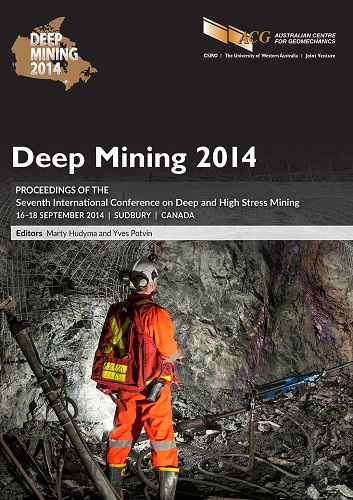The effect of the presence of salt formations above extracted copper ore as determined by numerical modelling

|
Authors: Pałac-Walko, B; Pytel, W Paper is not available for download Contact Us |
DOI https://doi.org/10.36487/ACG_rep/1410_27_Pytel
Cite As:
Pałac-Walko, B & Pytel, W 2014, 'The effect of the presence of salt formations above extracted copper ore as determined by numerical modelling', in M Hudyma & Y Potvin (eds), Deep Mining 2014: Proceedings of the Seventh International Conference on Deep and High Stress Mining, Australian Centre for Geomechanics, Perth, pp. 409-420, https://doi.org/10.36487/ACG_rep/1410_27_Pytel
Abstract:
Mining operations conducted in Polish copper mines at depths more than 1,200-1,500 m below the ground are becoming increasingly associated with an extensive and thick layer of rock salt. Because of its unique geomechanical properties, rock salt significantly stress and strain distribution within the main roof strata, including the copper ore production panels located below it, even at considerable distances. One would therefore expect that improved understanding of the phenomena associated with copper ore mining in such geological and high stress conditions could deliver new and important rock mechanics information that could be useful in the design of safe mine workings. Taking into account the scarcity of practical mining experience in such a geomechanical conditions, the considerable potential of numerical methods was harnessed for specific geomechanical risk identification and technological measures of risk controlling selection. A 3D numerical model based on the finite difference method (FDM) (FLAC3D 5.0 code) was used to simulate mining below the extended rock salt strata exhibiting rheological properties. The numerical model of the rock mass surrounding the production panels used the deformability-strength parameters, which were decreased to account for the effect of scale (values in situ). The rock mass numerical modelling results provided an important basis, from the geomechanical point of view, for drawing cognitive conclusions regarding the actual capabilities for safe copper ore exploitation, as well as the limitations constraining the geometry of technically-viable production panels and the parameters of applied room-and-pillar systems of mining. For this purpose, parametric analyses were performed, revealing the effect of (a) the thickness of the dolomite-anhydrite competent plate within the immediate overburden strata; (b) the length of the mining face; and (c) the ground control method, i.e. backfilling. It has been proven that the source of the main geomechanical risks may be attributed to the relatively low values of the rock salt’s strength properties, particularly its tensile strength. Moreover, the results obtained indicate that rock salt viscosity is not a critical parameter at the face advance rate applied in practice at the mines in question.
References:
Butra, J, Kijewski, P & Pytel, W 2006, ‘Geodynamic processes modelling in bedded hard rock – rock salt mass surrounding the Deep Glogow Commercial Copper Ore Reserves’, Proceedings of the 41st U.S. Rock Mechanics Symposium: Golden Rocks 2006, American Rock Mechanics Association, Alexandria.
Chugh, YP & Pytel, W 1992, ‘Design of partial extraction coal mine layouts for weak floor strata conditions’, U.S. Bureau of Mines Information Circular, no. 9315, pp. 32-49.
Itasca Consulting Group, Inc. 2014, FLAC3D: Fast Lagrangian Analysis of Continua in Three Dimensions, version 5, Itasca Consulting Group, Inc., Minneapolis,
Kłeczek, Z 1999, ‘Wytężenie górotworu solnego wokół podziemnych kawernowych magazynów gazu’, Czas. Nauk.-Techn. Górnictwa Rud Cuprum, no. 12.
Pytel, W 2003, ‘Rock mass – mine workings interaction model for Polish copper mine conditions’, International Journal of Rock Mechanics and Mining Sciences, vol. 40, pp. 497-526.
Pytel, W 2009, ‘Geodynamic Phenomena associated with copper ore mining below the rheological stratum’, in JA Hudson, LG Tham, X-T Feng & AKL Kwong (eds), Proceedings of the ISRM International Symposium on Rock Mechanics: Sinorock 2009, International Society for Rock Mechanics, Lisboa.
Pytel, W 2010a, ‘Technical feasibility for detector Glacier (Stage 1, Civil works), Geomechanical feasibility: stability calculations’, SIEROSZOWICE (SUNLAB) LAGUNA Design Study, Underground Infrastructure and Engineering Interim Report, EU FP7: Work Package 2: Deliverable 2.5, pp. 50-79.
Pytel, W 2010b, Numerical Analysis of Geomechanical Risks Associated with Copper Ore Mining Using A Continuous Miner, unpublished report for KGHM Polska Miedź S.A., Wrocław (in Polish).
Pytel, W & Butra, J 2006, ‘Dimensioning of Salt-Rock Pillars in “Polkowice-Sieroszowice” Copper Deep Mine Based on FEM’, in CF Leung & YX Zhou (eds), Proceedings of the 4th Asian Rock Mechanics Symposium: Rock Mechanics in Underground Construction, World Scientific, Singapore, 91-ARMS-A0211, on CD-ROM.
Pytel, W & Pałac-Walko, B 2011, ‘Strength of stratified rock mass beneath hard rock pillars’, in A Zharmenov, R Singhal & S Yefremova (eds), Proceeding of the 20th International Symposium on Mine Planning and Equipment Selection: MPES2011, on CD-ROM.
© Copyright 2025, Australian Centre for Geomechanics (ACG), The University of Western Australia. All rights reserved.
View copyright/legal information
Please direct any queries or error reports to repository-acg@uwa.edu.au
View copyright/legal information
Please direct any queries or error reports to repository-acg@uwa.edu.au